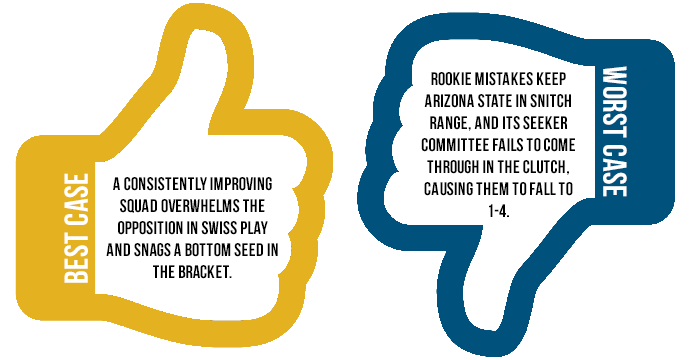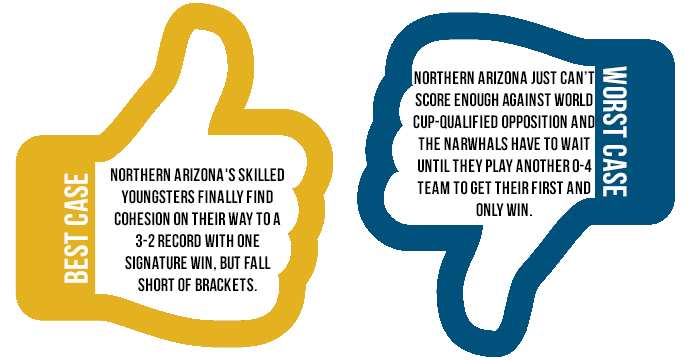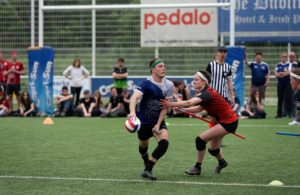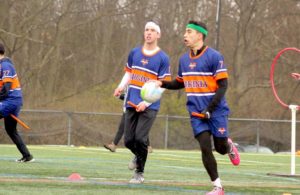- Rule, Britannia, no more?
- Unpopular Opinions: US Quadball Cup 2023
- Proven Contenders: University of Virginia
- Proven Contenders: Rutgers University
- Proven Contenders: University of Michigan
- Proven Contenders: Creighton University
- Different Perspectives: A Look Inside USA Ultimate
- Antwerp QC, Much of Belgian Core, Leaves Competitive Quidditch
Part XVI
Rock Hill Roll Call is your in-depth guide to the 80 teams that will compete for the title of World Cup 8 Champion. We’ve reached out to writers and analysts all over the country to bring you the lineups, strategies, focal points and aspirations of each and every attending team. Whether you are looking for a leg up on the competition or just want a detailed preview of the sport’s main event, this is the place for you.
 By Dan Hanson
By Dan Hanson
Arizona State University is one of the oldest programs in the West, and yet the West Regional semifinalist boasts one of the least-experienced rosters out of the region’s qualifying teams. That’s what made Arizona State such an exciting team to watch. Its steady improvement is not a fluke, and the team will likely perform similarly, if not even better, at World Cup 8 than it did at the West Regional.
The Sun Devils don’t have a particularly intimidating look about them, nor do they have have much size to go around, but they bring excellent speed and strength to the table. They prefer an extremely fast-pace game and almost always go all out to capitalize on a window of opportunity. But these are not the most notable traits of this squad. The quality opponents have found most recognizable about this year’s team is that it is decidedly not the Arizona State team of the past, known for grinding its opposition down with hard and often reckless contact. However, it’s still ready and able to throw the first punch.
It’s just a metaphorical punch nowadays. Arizona State has cleaned up its act since the end of last November’s West Regional Championship, and its jumble of new players has already formed a strong identity based on legal aggression and effort. It is extremely difficult to try harder than this team on the pitch. Hit one of these kids with a bludger, and they will be at their hoops and back in play without a moment of hesitation.
The Sun Devils have a full roster, so whether the aforementioned effort level continues to run high at World Cup will be a huge factor in their success, as they will be able to wear down teams late in Swiss play. They were able to get the jump on the heavily favored UCLA and Santa Barbara Blacktips squads in the West Regional Championship brackets because of their effort, but most of the teams they face at World Cup will be at that level or better.
 By Dan Hanson
By Dan Hanson
Arizona State’s range of experience as a team is demonstrated by its leaders: the new acquisition Michael Bernstein at the helm of the Sun Devils’ quaffle players and the veteran Josh Mattison leading their beaters.
Bernstein played for Florida State University last year and, upon transferring to Arizona State, found himself in a leadership role on a much better team full of new players. Stout, strong and a talented scorer and ball carrier, Bernstein provides the rookies with someone to look up to. That being said, he is still learning and growing. He has helped the Arizona State offense complete a great number of goals, but he is also prone to throwing away possessions with shots and passes that are too long. The same qualities can be found in the rest of his quaffle players: They are talented athletes who can score, but they also make decisions that lead to turnovers, as you would expect from, well, rookies. But overall, the Arizona State quaffle corps is already ahead of the curve, and with continued improvement to its strategy and decision-making, the Sun Devils could be a team that threatens to win a great deal of games in Rock Hill.
 This squad’s beaters, on the other hand, benefit from the proven veteran leadership of Josh Mattison. Mattison has always been a solid beater in a region full of good ones, but his best work may lie in how he has trained his rookie beaters. Mattison is still an extremely important player on the team, but he has found a more suitable role for himself lower on the depth chart, behind the beaters he helped train.
This squad’s beaters, on the other hand, benefit from the proven veteran leadership of Josh Mattison. Mattison has always been a solid beater in a region full of good ones, but his best work may lie in how he has trained his rookie beaters. Mattison is still an extremely important player on the team, but he has found a more suitable role for himself lower on the depth chart, behind the beaters he helped train.
If there is a breakout star of the rookie crop on Arizona State, it has to be Ryan McGonagle. McGonagle exemplifies the identity of the team: constant high levels of aggression and effort. McGonagle is a huge part of the offense–he throws off the rhythm of opposing beaters extremely well, creating all kinds of opportunities that Bernstein and company capitalize on excellently. McGonagle’s aggression does not mean he is stupid either. With rewards come many risks, but McGonagle’s superior speed helps him get to where he needs to be.
Meanwhile, at the seeker position, Blake Thurston leads a rotating committee that broke out at the West Regional Championship: Jarrod Bailey and Sam Frost caught the snitches in their qualifying and quarterfinal games, respectively. However, they haven’t proven that they will be able to consistently make those catches with the game on the line.
The separation of this team’s floor-to-ceiling potential at World Cup is huge, and it will come down to their beaters. McGonagle and his beating partner Vicky Sanford should only be better by World Cup, and it will be tremendous to watch how far these young players can take this team.
 By Greg Astolfi
By Greg Astolfi
The Southern Storm Griffins’ success in Rock Hill will hinge upon the team’s ability to finish out close games. In order to do so, it will need to focus and improve on its play while the snitch is on pitch.
During the South Regional Championship, the Griffins managed to keep five out of the six games they played in range. The one outlier was their 210*-80 victory over the Muggle Snugglers in the consolidation bracket semifinals. Despite having a chance to win every game it played, Southern Storm only went 2-5 in SWIM situations.
Imagine how much further this team could have gone with just a few more snitch grabs. The three games the Griffins dropped at the regional were all to other World Cup qualifiers (University of South Florida, University of South Carolina and Florida Gulf Coast University). What is even more intriguing is that Southern Storm was never down by more than 20 at the time of the snitch catch in any of these games. In order for things to turn around before April, this team will have to develop a different, more effective strategy once 18 minutes have passed.
If change is to happen it will have to fall on the shoulders of this team’s chasers. Southern Storm’s defense is predicated on a strong beating corps that allows them to control the pace of the game and keep scores low. As a result, the chasers do not have to put up a lot of points per game in order to keep the score in range. Though this did not prove problematic enough for the team to fall short of a bid, it will be the Griffins’ make or break at World Cup.
Against more skilled or physical chaser corps, Southern Storm team struggles to put points on the board. This trend can be seen in the results from Old Money Classic II where the team only put 10 points on the board against the Appalachian Apparators and a combined 100 points in two games against UNC. Furthermore, on defense, the Griffins struggle to slow down physical drivers without their beaters. This has ultimately led to problems during the time the snitch is on the field.
During seeker play, Southern Storm’s beaters are caught between defending the seeker and stopping the quaffle. This results in the team’s beating defense becoming overstretched. With the increased competition at World Cup, the chasers are going to have to develop a stronger offense as well as work on avoiding overextending the Griffins’ defense. Developing a strategy where the chasers can stop drives with more physicality and less beater support would be a huge boost.
If its chasers can focus and improve in the aforementioned areas before April, Southern Storm could see some success. After that, the only remaining question is: Can they come away with a grab for the win?
 By Greg Astolfi
By Greg Astolfi
If you play quidditch outside of the South, you have probably never heard of Southern Storm. But don’t worry about it–you’re not the only one.
This first-year community team that calls the border between the Carolinas home punched its ticket to World Cup 8 via a finals victory in the consolation bracket of the South Regional Championship. However, don’t let the first-year status fool you. This team may lack star power, but it is loaded with experienced players up and down their roster. Beater Ginny Ostgaard and chaser/keeper Billy Hoyle were founding members of the Appalachian Apparators as well as members of the Quidditch Club of the Carolinas’ World Cup VI roster. The team also features Joey Galtelli, Zoe Walsh, Anderson Breeland and Hanna Reese, all of whom played in World Cup VI’s Division II.
 Outside of experience, what stands out about Southern Storm is the team’s ability to play to its strengths, namely, strong beating and a slow methodical pace. Led by Tanner Morris, this beating lineup is defensively sound and dictates the pace of the team’s game. Morris, who is more commonly known for his performance as the “Captain America” snitch–the guy in The Eighth Man’s cover photo–is a strong, physically-imposing beater. He creates mismatches for smaller beaters, and his strong, accurate throws allow him to cover a wide range of area. This makes it much harder to score for teams that like to drive the quaffle through the middle of the field. To score against this defense, opposing teams need to run an accurate passing game with sharp cuts around the hoops or try to force this team into no-bludger situations to create open driving lines.
Outside of experience, what stands out about Southern Storm is the team’s ability to play to its strengths, namely, strong beating and a slow methodical pace. Led by Tanner Morris, this beating lineup is defensively sound and dictates the pace of the team’s game. Morris, who is more commonly known for his performance as the “Captain America” snitch–the guy in The Eighth Man’s cover photo–is a strong, physically-imposing beater. He creates mismatches for smaller beaters, and his strong, accurate throws allow him to cover a wide range of area. This makes it much harder to score for teams that like to drive the quaffle through the middle of the field. To score against this defense, opposing teams need to run an accurate passing game with sharp cuts around the hoops or try to force this team into no-bludger situations to create open driving lines.
As for the chasers on this team, their objective is clear: Score enough points to stay in range. However, this is not necessarily an arduous task in an overall weaker South region. The team’s chasers’ primary style of attack is to move up the field cautiously, slowing the pace with heavy passing even before reaching half field. If they feel their approach is breaking down, they will not hesitate to reset. This strategy has worked thus far for the team in a region where you only need between 20-50 points to stay in range. However, at World Cup, the Griffins will face much stronger competition than they did at the South Regional Championship. If this community team wants a chance at coming away with wins in Rock Hill, it will need to prove it can match the same level of output offensively and defensively that it showed at its regional. If Southern Storm can achieve this and continue to improve, then it stands to reason that the Griffins can come away with some wins against middle-tier teams.
 By Dan Hanson
By Dan Hanson
There are two factors that will determine the success of Northern Arizona University at World Cup 8: Paulo Pena and the team’s extensive use of utility players.
First off, let’s talk about the Narwhals’ rookie of the year. Keeper Pena is a big scoring threat from shooting to driving. However, his downfall is one many rookies fall victim to–he can sink a great long shot, but then he assumes he can do it again and again. This results in a number of quaffles sailing over the hoops or directly into the keeper’s hands.
That being said, Pena demands a lot of attention from defenses because if his shots are on point or a lane is open, he’s likely to score. Unfortunately for the opposition, this demand for attention opens up scoring opportunities for the other talented players.
When playing the Narwhals, you can bet the quaffle will be in Pena’s hands more often than not. However, you will have much more trouble predicting what roles the team’s slew of utility players will take on, leading us to the next x-factor for this squad.
Outside of Pena, Northern Arizona is known for using its best players flexibly across positions. One of the Narwhals’ veterans and best players, Steven Gruenewald, almost exclusively donned a black headband for years. This season, however, he is the definition of a utility player. He has showed crucial scoring skills at chaser and keeper on multiple occassions. At Crimson Cup, he showed the ability to step up in the absence of Porter Marsh, making clutch, flashy catches at seeker.
Speaking of Marsh, this famous seeker tried his hand at beater during the seeker floor last year, and this year he has shifted his focus to chasing. While he’s not a standout at either position, Marsh puts up a consistently solid performance in both positions and can be expected to make important contributions before his time to shine at 18 minutes each game.
Northern Arizona has shown a lot of flexibility in their gameplay strategies by using players who show strengths in multiple roles. However, that flexibility doesn’t buy them much if they can’t show chemistry as a unit, which this very young group has yet to do.
 By Dan Hanson
By Dan Hanson
Northern Arizona’s season has been so notably inconsistent that it has been hard to keep track of whether this team is on the rise or fall.
After a paltry 10th-place finish at the West Regional Championship, it’s hard to remember back to early fall when the team looked like it would match its performance as regional semifinalists from last season. After an impressive second-place finish to the LA Gambits at Crimson Cup, the self-inflicted wound of the unofficial Lumberjack Invitational wiped away the memory of Northern Arizona’s best performance of the season. The team achieved notable wins over Arizona Quidditch Club and the Crimson Elite before winning the ill-fated unofficial rematch in the final against AZQC and taking the tournament.
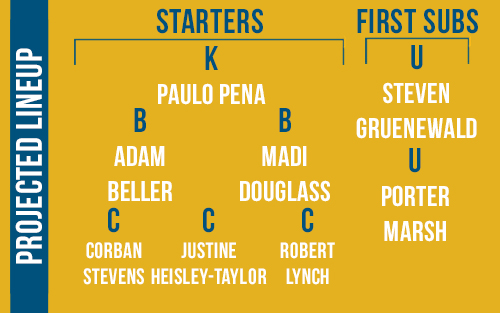 Since Lumberjack, Northern Arizona’s captain and centerpiece Greg Leininger transferred to AZQC, leaving the Narwhals in the dust in terms of national relevance. The other big loss for Northern Arizona since the fall is the speedy utility player Luke Sanchez. These losses could explain Northern Arizona’s decline, but it appeared on paper that the Narwhals made up for these players with a very strong crop of freshman.
Since Lumberjack, Northern Arizona’s captain and centerpiece Greg Leininger transferred to AZQC, leaving the Narwhals in the dust in terms of national relevance. The other big loss for Northern Arizona since the fall is the speedy utility player Luke Sanchez. These losses could explain Northern Arizona’s decline, but it appeared on paper that the Narwhals made up for these players with a very strong crop of freshman.
Despite the new recruits, red flags popped up at the Arizona Championship Showcase, where Northern Arizona struggled offensively but pulled out a 20-point victory over Arizona State University and then split a pair of snitch-range games with AZQC. It was the Northern Arizona we’ve known for years: a stingy defense that keeps games in range for seeker Marsh to seal the win. However, within the two weeks before the West Regional, Arizona State demonstrated some major, rapid improvement and AZQC returned to form, leaving the Narwhals as the clear third team in Arizona.
Northern Arizona simply could not score in its big games at the regional championship. The very young Utah State University held Northern Arizona to 20 points until just before the end of the seeker floor. The Silicon Valley Skrewts–a supposed “even match” for the Narwhals–shut them out completely. In the consolation bracket, they couldn’t stay out of range against a weaker Riverside Quidditch squad.
Now, the team finds itself at a crossroads, as it always seems to be before World Cup. In 2013, the Narwhals looked like a mess and then plowed their way to an Elite Eight finish. In 2014, they looked strong in spite of roster-related suspensions, but disappointed in the long run. Does that mean the team will give us a pleasant surprise at World Cup 8, or will it continue its downward trend? Spirit fingers until we find out.



